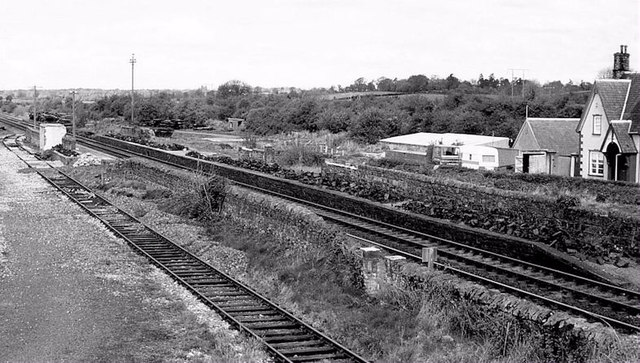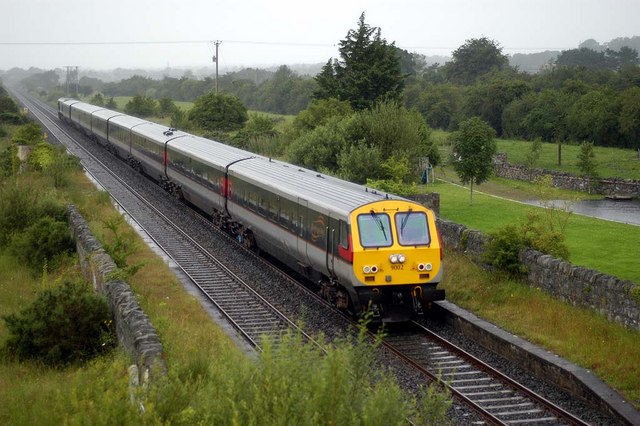|
Dublin And Belfast Junction Railway
Dublin and the Belfast Junction Railway (D&BJct, Irish: Iarnród Bhaile Átha Cliath agus Acomhal Bhéal Feirste) was an Irish gauge () railway in Ireland. The company was incorporated in 1845 and opened its line in stages between 1849 and 1853, with the final bridge over the River Boyne opening in 1855. It linked the Ulster Railway (UR) from Belfast to Portadown and Dublin and Drogheda Railway (D&D) from Drogheda to Dublin, completing the missing link in the Belfast–Dublin line. History The Boyne Viaduct at Drogheda was not built until 1854–55, at a cost of £124,000, to the design of Sir John Macneill, who was the consulting engineer for the D&BJct. Route The D&BJct line from Drogheda to Portadown connected the Ulster Railway's – – Belfast original line with the Dublin and Drogheda Railway's Dublin Amiens Street – Drogheda line, forming the main line between Dublin and Belfast. Aftermath In 1875, the D&BJct merged with the Dublin and Drogheda Railway (D&D ... [...More Info...] [...Related Items...] OR: [Wikipedia] [Google] [Baidu] |
Tanderagee Railway Station
Tanderagee railway station was opened on 6 January 1852. It was originally named Madden Bridge and was located on the Madden road between the villages of Tandragee, County Armagh and Gilford, County Down, Northern Ireland Northern Ireland ( ga, Tuaisceart Éireann ; sco, label= Ulster-Scots, Norlin Airlann) is a part of the United Kingdom, situated in the north-east of the island of Ireland, that is variously described as a country, province or region. Nort .... It closed on 4 January 1965. Tanderagee is also spelt as Tandragee, after the nearby village. Tanderagee and Gilford railway station was the original name upon opening of the station. Only the two platforms remain, the station buildings having been demolished. References Disused railway stations in County Armagh Railway stations in Northern Ireland opened in 1852 1852 establishments in Ireland Railway stations in Northern Ireland opened in the 19th century {{NorthernIreland-railstation-st ... [...More Info...] [...Related Items...] OR: [Wikipedia] [Google] [Baidu] |
Dublin Connolly Railway Station
Connolly station ( ga, Stáisiún Uí Chonghaile) or Dublin Connolly is one of the busiest railway stations in Dublin and Ireland, and is a focal point in the Irish route network. On the North side of the River Liffey, it provides InterCity, Enterprise and commuter services to the north, north-west, south-east and south-west. The north–south Dublin Area Rapid Transit (DART) and Luas light rail services also pass through the station. The station offices are the headquarters of Irish Rail, Iarnród Éireann. Opened in 1844 as ''Dublin Station'', the ornate facade has a distinctive Italianate tower at its centre. History On 24 May 1844 the Dublin and Drogheda Railway (DDR) began public operations from an interim terminus at the Royal Canal, and on the same day the foundation stone for what is now Connolly station was laid by Earl de Grey, Lord Lieutenant of Ireland. The station was opened for operations on 29 November 1844 as ''Dublin Station'', but was renamed ''Amie ... [...More Info...] [...Related Items...] OR: [Wikipedia] [Google] [Baidu] |
Railway Companies Disestablished In 1875
Rail transport (also known as train transport) is a means of transport that transfers passengers and goods on wheeled vehicles running on rails, which are incorporated in tracks. In contrast to road transport, where the vehicles run on a prepared flat surface, rail vehicles (rolling stock) are directionally guided by the tracks on which they run. Tracks usually consist of steel rails, installed on sleepers (ties) set in ballast, on which the rolling stock, usually fitted with metal wheels, moves. Other variations are also possible, such as "slab track", in which the rails are fastened to a concrete foundation resting on a prepared subsurface. Rolling stock in a rail transport system generally encounters lower frictional resistance than rubber-tyred road vehicles, so passenger and freight cars (carriages and wagons) can be coupled into longer trains. The operation is carried out by a railway company, providing transport between train stations or freight customer faciliti ... [...More Info...] [...Related Items...] OR: [Wikipedia] [Google] [Baidu] |
Railway Companies Established In 1845
Rail transport (also known as train transport) is a means of transport that transfers passengers and goods on wheeled vehicles running on rails, which are incorporated in tracks. In contrast to road transport, where the vehicles run on a prepared flat surface, rail vehicles (rolling stock) are directionally guided by the tracks on which they run. Tracks usually consist of steel rails, installed on sleepers (ties) set in ballast, on which the rolling stock, usually fitted with metal wheels, moves. Other variations are also possible, such as "slab track", in which the rails are fastened to a concrete foundation resting on a prepared subsurface. Rolling stock in a rail transport system generally encounters lower frictional resistance than rubber-tyred road vehicles, so passenger and freight cars (carriages and wagons) can be coupled into longer trains. The operation is carried out by a railway company, providing transport between train stations or freight customer faciliti ... [...More Info...] [...Related Items...] OR: [Wikipedia] [Google] [Baidu] |
Great Northern Railway (Ireland)
The Great Northern Railway (Ireland) (GNR(I) or GNRI) was an Irish gauge () railway company in Ireland. It was formed in 1876 by a merger of the Irish North Western Railway (INW), Northern Railway of Ireland, and Ulster Railway. The governments of Ireland and Northern Ireland jointly nationalised the company in 1953, and the company was liquidated in 1958: assets were split on national lines between the Ulster Transport Authority and Córas Iompair Éireann. Foundation The Ulster, D&D and D&BJct railways together formed the main line between Dublin and Belfast, with the D&BJct completing the final section in 1852 to join the Ulster at . The GNRI's other main lines were between Derry and and between Omagh and Portadown. The Portadown, Dungannon and Omagh Junction Railway together with the Londonderry and Enniskillen Railway enabled GNRI trains between Derry and Belfast to compete with the Belfast and Northern Counties Railway, and both this and the Dundalk route gave connectio ... [...More Info...] [...Related Items...] OR: [Wikipedia] [Google] [Baidu] |
Northern Railway Of Ireland
Northern Railway of Ireland was an Irish gauge railway company in Ireland. It was formed by a merger of the Dublin and Drogheda Railway (D&D) with the Dublin and the Belfast Junction Railway (D&BJct) in 1875. In 1876 it merged with the Irish North Western Railway (INW) and Ulster Railway to form the Great Northern Railway (Ireland) The Great Northern Railway (Ireland) (GNR(I) or GNRI) was an Irish gauge () railway company in Ireland. It was formed in 1876 by a merger of the Irish North Western Railway (INW), Northern Railway of Ireland, and Ulster Railway. The government .... Railway companies established in 1875 Railway companies disestablished in 1876 Irish gauge railways Great Northern Railway (Ireland) Defunct railway companies of Ireland {{Europe-rail-transport-stub ... [...More Info...] [...Related Items...] OR: [Wikipedia] [Google] [Baidu] |
Belfast
Belfast ( , ; from ga, Béal Feirste , meaning 'mouth of the sand-bank ford') is the capital and largest city of Northern Ireland, standing on the banks of the River Lagan on the east coast. It is the 12th-largest city in the United Kingdom and the second-largest in Ireland. It had a population of 345,418 . By the early 19th century, Belfast was a major port. It played an important role in the Industrial Revolution in Ireland, briefly becoming the biggest linen-producer in the world, earning it the nickname "Linenopolis". By the time it was granted city status in 1888, it was a major centre of Irish linen production, tobacco-processing and rope-making. Shipbuilding was also a key industry; the Harland and Wolff shipyard, which built the , was the world's largest shipyard. Industrialisation, and the resulting inward migration, made Belfast one of Ireland's biggest cities. Following the partition of Ireland in 1921, Belfast became the seat of government for Northern Ireland ... [...More Info...] [...Related Items...] OR: [Wikipedia] [Google] [Baidu] |
Dublin
Dublin (; , or ) is the capital and largest city of Republic of Ireland, Ireland. On a bay at the mouth of the River Liffey, it is in the Provinces of Ireland, province of Leinster, bordered on the south by the Dublin Mountains, a part of the Wicklow Mountains range. At the 2016 census of Ireland, 2016 census it had a population of 1,173,179, while the preliminary results of the 2022 census of Ireland, 2022 census recorded that County Dublin as a whole had a population of 1,450,701, and that the population of the Greater Dublin Area was over 2 million, or roughly 40% of the Republic of Ireland's total population. A settlement was established in the area by the Gaels during or before the 7th century, followed by the Vikings. As the Kings of Dublin, Kingdom of Dublin grew, it became Ireland's principal settlement by the 12th century Anglo-Norman invasion of Ireland. The city expanded rapidly from the 17th century and was briefly the second largest in the British Empire and sixt ... [...More Info...] [...Related Items...] OR: [Wikipedia] [Google] [Baidu] |
John Benjamin Macneill
Sir John Benjamin Macneill FRS (1793 – 2 March 1880) was an eminent Irish civil engineer of the 19th century, closely associated with Thomas Telford. His most notable projects were railway schemes in Ireland. Life He was born in Mountpleasant near the town of Dundalk, County Louth, Ireland. Macneill started initially as a surveyor and was employed practically in laying out roads and other engineering works since 1816. His survey of the Boyne estuary became the basis of a report by Alexander Nimmo in 1826. During a trip to England in the 1820s he met engineer Thomas Telford who inspired him to become a civil engineer. Indeed, he became Telford's chief assistant for 10 years, eventually succeeding Telford as chief engineer on the massive London–Holyhead road project. He developed Macneill's road indicator in the late 1820s, an instrument for ascertaining the force necessary to draw a carriage over different kinds of roads and pavements, and consequently, the actual conditio ... [...More Info...] [...Related Items...] OR: [Wikipedia] [Google] [Baidu] |
Boyne Viaduct
, native_name_lang = , image = 02 Boyne Viaduct Drogheda 2007-10-5.JPG , image_size = , alt = , caption = , official_name = , other_name = , carries = Belfast-Dublin railway line , crosses = River Boyne , locale = Drogheda , owner = , maint = Iarnród Éireann , id = , architect = , designer = John Benjamin Macneill , engineering = , design = Stone arch & Iron truss , material = , length = , width = , height = , mainspan = , spans = , pierswater = , load = , clearance = , below = , life = , builder = , fabricator = , begin = 1851 , complete = 1855 , cost = , open = , inaugurated = , toll = , traffic ... [...More Info...] [...Related Items...] OR: [Wikipedia] [Google] [Baidu] |





.png)

.jpg)
.jpg)